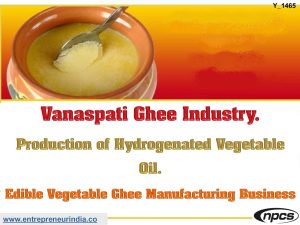
Vanaspati Ghee Industry. Production of Hydrogenated Vegetable Oil. Edible Vegetable Ghee Manufacturing Business
Vanaspati is a fully or partially hydrogenated vegetable cooking oil often used as a cheaper substitute for ghee. Vanaspati is a desi vegetable ghee that has been hydrogenated and hardened. It is much cheaper than desi ghee. All brands of Vanaspati are made from palm or palm olein oil. Hydrogenation is brought about by using nickel as a catalyst in reactors at low to medium pressure. Vanaspati contains trans fats. It is used for cooking purposes in different domestic and commercial places. They are rich in the taste and flavor.
Ghee is primarily used for cooking and frying and as dressing or toppings for various foods. It is also used in the manufacture of snacks and sweets often mixed with vegetables, cereals, fruits, and nuts. In some parts of the world, ghee is considered as a sacred product and is used in religious rites. It could also be mentioned that ghee is used in Ayurveda, which is a system of traditional medicine developed in India several thousand years ago and now also practiced in other parts of the world as alternative medicine.
There are various different forms of edible oil found in the market. One of the old and most highly used form is the vanaspati ghee; this is a cheaper version of the pure ghee which is the most used and ancient form of fatty oil used by Indians made from cow milk.
In India, the main source of trans fat is Vanaspati, a form of vegetable ghee that is a Partially Hydrogenated Vegetable Oil (PHVO). Vanaspati has an important role in our edible oil economy. Its production is about 1.2 million tonnes annually. It has around 10% share of the edible oil market. Newer oils like soyabean, sunflower, rice bran and cottonseed and oils from oilseeds of tree and forest origin had found their way to the edible pool largely through vanaspati route.
In India the consumption of edible oils and Vanaspati is comparatively high as compared to any other country. Peoples in India use Vanaspati and oil on daily basis particularly for cooking food. India’s current population is 1.25 billion and expected to grow 1.53 billion by 2030. In future when the population rises, the demand for oils and Vanaspati will also rise respectively. Even with a moderate population growth the absolute increase in number of people will be quiet high.
As the social class tapers at the bottom and more families climb up the middle class from lower class, both per capita consumption as well as consumption of packaged food supplies increases. However, since Vanaspati is more preferred by lower class and the middle class favours oil to Vanaspati ghee, there could be a reverse trend of giving up use of Vanaspati in favour of refined oil. However, the double digit growth of out of home consumption of edible oil will tip in favour of indirect consumption of Vanaspati
The market is further expected to reach a value of INR 4,653 Billion by 2024. The healthy growth of the market can be attributed to numerous forces. Population growth, rising disposable incomes, easy availability, and growing awareness about the benefits of ghee are some of the factors that are broadening the growth aspects of the market.
At present, ghee is witnessing an escalation in demand across India on account of an increase in disposable incomes which has enabled consumers from lower income groups to afford it. Besides, as ghee does not require refrigeration and is shelf stable, it is preferred over its alternatives such as butter. Apart from this, a rise in the number of restaurants offering traditional Indian food is also giving a boost to the overall consumption of ghee.
Moreover, numerous doctors in the country recommend moderate consumption of ghee daily as it helps in reducing inflammation, building strong bones and improving digestion. However, widespread adulteration of ghee, especially with refined and hydrogenated vegetable oils, is hindering the market growth in India.
The consumption of ghee has increased, as it is rich in fat soluble vitamins A, D, & E, helps in building strong bones, improves digestion, and reduces inflammation. The plethora of health benefits and high penetration in the emerging market are the key drivers of the market growth. Further, high disposable income and population boom are expected to present lucrative opportunities to market players. However, overconsumption of ghee could lead to cardiovascular diseases, which in turn is key factor affecting the market growth during the forecast period.
Population growth, health benefits, increasing disposable incomes and penetration in newer markets currently represent some of the key factors driving the demand of this product.
In 2017, the global Ghee market size was million US$ and is forecast to million US in 2025, growing at a CAGR of from 2018. The global ghee market is segmented based on application and geography. On the basis of application, it is divided into household and industrial. Geographically, it is analyzed across North America, Europe, Asia-Pacific, and LAMEA.
Comprehensive competitive analysis and profiles of major market players, such as Amul, Britannia, Milkfood, Madhusudan Ghee, KMF, Nestle, Verka, Gopaljee Ananda, Gowardhan, and Anik are provided in the report.
The Top Players Including:
- Verka
- Sterling Agro Industries Ltd.
- Vrindavan Milk
- Amul
- Udhaya Krishna Pure Ghee
- RKG Ghee
- Param Dairy Ltd
- Govind Milk & Milk
- Shree Radhe Dairy Farm & Foods Pvt. Ltd
- MLP Balakrishna ghee
- Vrindavan Milk
- Karnataka Co-operative Milk Producers’ Federation Ltd.
- Creamline Dairy Products Ltd
- ONganic Foods
- AAC Ghee
See more